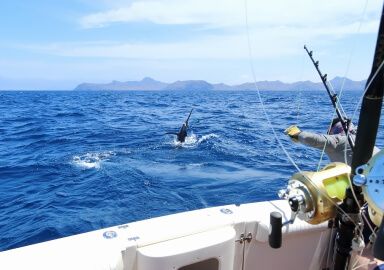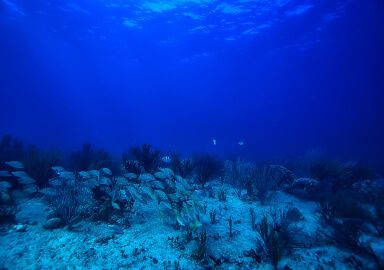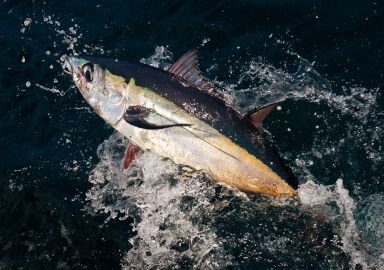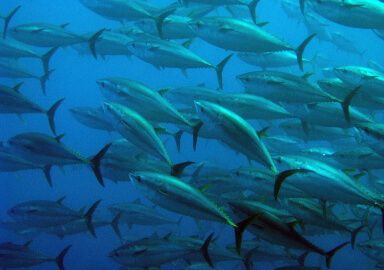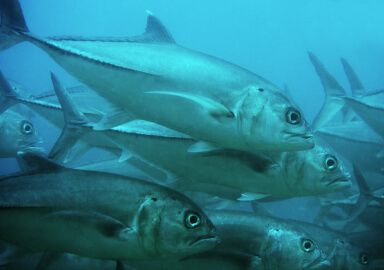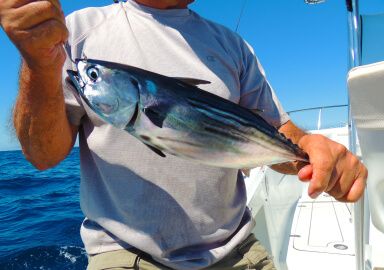Bigeye Tuna
The deep diver of the tuna family, the bigeye tuna are vital to commercial fisheries and are considered a highly prized catch for recreational anglers.
View 34 listings
34
listings
–
price starting from
11
countries
–
to the nearest trip
Where and When?
Bigeye tuna are widely distributed across tropical and subtropical waters of the Atlantic, Pacific, and Indian Oceans. They are a highly migratory species, often traveling long distances across oceans to follow their prey or to reach breeding grounds. Bigeye tuna are commonly found in the open ocean, far from shore, and prefer waters ranging in temperature from 17°C to 22°C (63°F to 72°F).
Some of the best locations to fish for bigeye tuna include Hawaii, especially along the Kona Coast, Macaronesia (don’t know where that is? Read our blog and find out!), the Pacific coast of Costa Rica, especially around offshore structures and seamounts near the Osa Peninsula and the FADs (Fish Aggregating Devices) deployed in deeper waters, and in the Maldives. Bigeye tuna fishing is highly seasonal, depending on the region. Generally, the best time to target them is May to September in the Atlantic Ocean, June to November in the Pacific, and December to March in the Indian Ocean.
About Bigeye Tuna
Bigeye tuna are one of the larger species of tuna, with adults typically reaching lengths of 1.5 to 2 meters (5 to 6.5 feet) and weighing between 150 to 250 kg (330 to 550 lbs). The largest recorded individuals can weigh over 400 kg (880 lbs). Bigeye tuna have a robust, torpedo-shaped body that is built for speed and endurance. Their coloration is dark metallic blue on the back and upper sides, while the lower sides and belly are silver with a slight sheen. A distinguishing feature of the bigeye tuna is their large, round eyes, which are adapted for seeing in deeper, dimmer waters. They also have a series of small finlets between the second dorsal fin and the tail, which helps them maintain speed and stability while swimming.
Bigeye tuna are opportunistic predators, feeding on fish such as mackerel and sardines, as well as squid, crustaceans, and cephalopods. They have a unique adaptation in which they can regulate their body temperature, allowing them to dive into cooler, deeper waters - over 500 meters (1,640 feet) in depths - that other tuna species cannot access. This adaptation, as well as enhanced vision ensured by large eyes they owe their name to, allows them to exploit different feeding grounds, going deep during the day and rising to surface waters at night.
Bigeye tuna reach sexual maturity at about 3 to 4 years of age. Spawning occurs in warm, tropical waters, with peak periods varying by region. In the Pacific, spawning typically occurs between April and September, while in the Atlantic, it peaks from June to September. Bigeye tuna are serial spawners, meaning that females release eggs multiple times throughout the spawning season. A single female can produce several million eggs per spawning event. The eggs hatch into larvae, which drift in the plankton before developing into juveniles. Juveniles are more commonly found in surface waters, while adults prefer deeper waters.
How to Catch?
Catching bigeye tuna is a rewarding but challenging endeavor due to their size, strength, and deep-water habits. In the daytime, these fish are typically found in depths between 200 and 500 meters (650 to 1,640 feet). Anglers targeting bigeye often head offshore to deep drop-offs and seamounts. If you don’t have specialized rigs that can reach down below, you would have to resort to night fishing, when they tend to come closer to the surface to feed. Another trick is to hit areas where cold, nutrient-rich waters rise to the surface, attracting baitfish and other prey, or Fish Aggregating Devices (FADs), where they are also often found.
Trolling is the most common method for catching bigeye tuna. The trolling speed for bigeye is typically slower than for other tuna species, usually between 4.5 to 8 knots, which helps to bring the lures down below. Bigeye tuna are drawn to brightly colored lures such as cedar plugs, plastic squids, and skirted trolling lures. Lures should be staggered at different distances behind the boat to cover more water and maximize the chances of a strike. Deep dropping, with natural bait such as sardines, is also effective, but requires specialized deep-water reels and weights, as well as sonars to precisely locate schools at depth.
Bigeye tuna tend to come closer to the surface at night to feed. Anglers often target them after dark using chunking or trolling with lures and live bait. Glow-in-the-dark lures or phosphorescent jigs can be especially effective at night. The reduced light makes bigeye less cautious, increasing the likelihood of a strike. Once a bigeye tuna takes the bait or lure, the angler must set the hook firmly. Bigeye tuna are strong fighters, notorious for deep, powerful runs, and landing one can take time.




